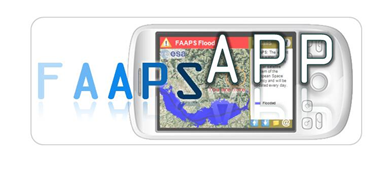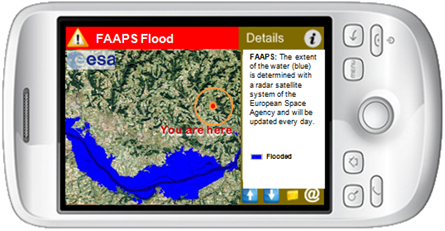
Objectives of the service
FAAPS aims at making readily available large scale flood map information to emergency management professionals. The information will be derived from the near real time (NRT) processing of Earth Observation Synthetic Aperture Radar (SAR) data and will be delivered through the Internet to professional grade GIS (Geographical Information System) workstations as well as to consumer mobile devices (desktop, tablet, smartphone). Therefore the FAAPS service can potentially be of help of any person confronted to a flood crisis situation whether he/she works in a disaster centre, conducts rescue operations or is a regular citizen at risk. Additionally FAAPS time-tagged flood extent maps can greatly support insurances and re-insurers companies to assess damage experienced by their customers during a flood.
The project objectives are to develop, validate, demonstrate and assess the benefits for flood management authorities of a future operational service delivering NRT flood extent maps generated by processing ESA satellite data. During this project a fully automatic processing chain will be implemented and validated (without manual interaction, which is currently unique) together with two interfaces for the service provision:
- The FAAPS mobile application : will be a location based smart phone / tablet application displaying latest flood information on a map background together with the user's position (rescuer or standard citizen). The application will enable individuals to evaluate the extent of the flood situation, take precautionary measures and possibly reduce the likelihood of human and economic losses.
- The FAAPS professional gateway will provide disaster management teams with an on-line access to current and historic flood extent maps directly compatible with their current working environment (including GIS) and with the capability to overlay these data with numerous other data sets.

During the project's demonstration period, the FAAPS system will process historic data (from 2005 to 2011) acquired by ESA Envisat satellite ASAR instrument. However the FAAPS system shall be scalable to process future Sentinel-1 data as soon as operationally available. The produced water masks will be made available through both interfaces to Austrian authorities in charge of flood monitoring and management activities. The users involved in the project will assess the benefits of the service with regards to their needs and requirements.
Users and their needs
The main user groups targeted by FAAPS are:
- Civil Protection Agencies. Civil protection relates to measures aimed at protecting populations and their environment against accidents and disasters. Civil protection agencies are legally responsible for handling matters involving criminal threats, catastrophes and hazards (e.g. fires, floods) national defence, surveillance, and radioactive contamination.
- Disaster Management Centres which are responsible for coordinating precautionary actions and measures aiming at preventing catastrophes, managing and reducing their impacts, coordinating rescue operations, and performing disaster relief and economic assessments. Disaster Management Centres usually coordinate the actions of state institutions (e.g. authorities, emergency response units), associations and NGOs (e.g. volunteers) and citizens and private firms (called self-protection).
- Emergency response units which are (for example) the police, fire brigades, ambulances, mountain rescue service or the Armed Forces.
Austrian representatives of the above target users are involved in the project. They are in charge of expressing their needs and requirements and providing feedback about the FAAPS demonstration service. These users are:
- Office of the Styrian Government, Department for Protective Hydraulic Engineering and Soil Water Management
- Federal Government of Lower Austria, Department for Fire and Civil Protection
- Ministry of Agriculture and Forestry, Environment and Water Management
- Ministry of the Interior, Department II/4/a Disaster Management
- Province Styria Disaster Management
Service/ system concept
A flood is a process and not a situation, thus there are different phases during a flood event, each of which requires specific flood and flood risk information on different levels and for different recipients.
For example, at the beginning of a flood event, the knowledge of the current flood situation by civil protection organisations and rescue teams (but possibly by insurances and citizens) can greatly prevent damages and casualties. Such a scenario could be fulfilled thanks to FAAPS by delivering daily large scale flood extent maps and flood risk maps derived from historical analyses.
On a more general basis, once operational FAAPS will deliver:
- EO-based flood map information freely and readily available to the citizen,
- A professional data gateway accessible to disaster management centres and field emergency and response units
Historical flood data for a real-world identification (not based on models) and determination of flood risks
Space Added Value
Space based flood monitoring allows a comprehensive overview of the area concerned in relative short time. In emergency situations, near real time radar (SAR) imagery is available and also during bad weather conditions.
Satellite positioning, allows to deliver to users in the field (e.g. emergency units) the maps near their current position. Consequently emergency units in the field shall not waste time by selecting the right flood maps. Fast location based information delivery is essential when it comes to time critical decision making.
Current Status
The Final Review of the project was held in September 2013. The project is now closed and the consortium plans to proceed with the commercialisation of the FAAPS service as soon as ESA Sentinel-1 data is available.





